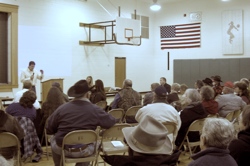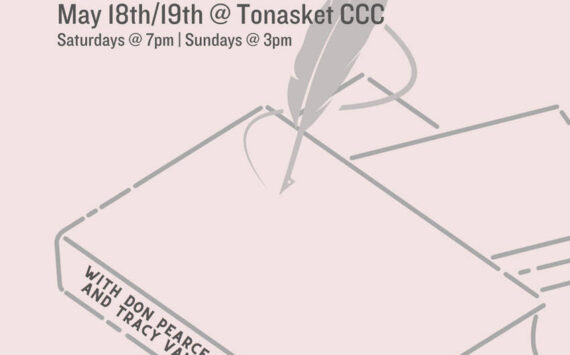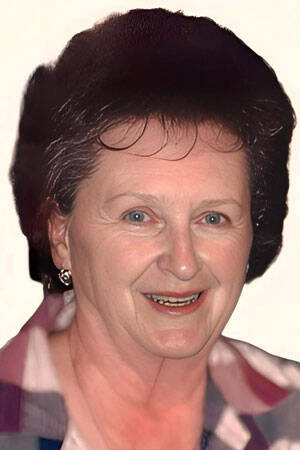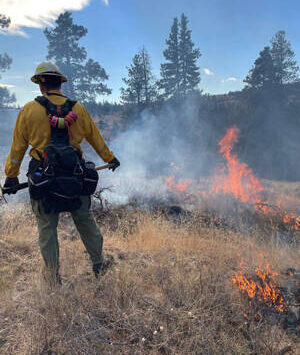

A crowd of about 50 people met at the Virginia Grainger Elementary School on Thursday, Dec. 3 to continue discussions on the Okanogan County Comprehensive Plan. Jon Wyss of the coalition was the main speaker. Photos by Emily Hanson
OKANOGAN – About fifty people were in attendance for the latest meeting of the Okanogan Coalition for Property Rights at the Virginia Grainger Elementary School on Thursday, Dec. 3.
The purpose of this second meeting, which was much smaller than the first 800 person meeting in November, was to go over the top ten issues the coalition has with the draft of the Okanogan County Comprehensive Plan.
“We wanted tonight’s meeting to be small,” Jon Wyss, the chairman of the coalition, said. “We’re going to have another meeting like this in January when this plan really gets going. We wouldn’t be here tonight if the comprehensive plan were done.”
When one man in the crowd suggested the coalition create their own comprehensive plan to send to the Okanogan County Commissioners, Wyss said the coalition is working on that right now.
“We are working on a draft document and comparing it to the current 1964 plan and the commissioners draft document,” Wyss said. “We are making considerable adjustments because there are considerable issues with this plan. We are planning to send these documents to each member of the coalition in order to get comments on it from each member so that during the hearings specific comments can be made and also solutions to problems can be suggested.”
Wyss then went through the top ten issues the coalition has with the comprehensive plan as stated in a handout given to everyone in attendance. Issue number one referred to line 70 of the comprehensive plan with states “just as the Constitution guarantees our rights to own and use the land it requires us to respect the rights and freedoms of others.”
“My copy of the constitution does not say this,” the coalition states as the problem. “What the constitution does say is governments “are established to protect and maintain individual rights’ and that “no person shall be deprived life, liberty or property without due process of law’ and that “no person shall be disturbed in his private affairs or his home invaded without authority of law.'”
The solution to this problem, the coalition says, is to remove the original statement or to replace it with the actual words from the constitution.
The second issue refers to lines 215-217 of the plan, the section titled “finding of fact and conclusions of law.’
“Only a court can establish conclusions of law and this statement sets a predetermined legal conclusion,” the coalition states as the problem. “The solution is to change the wording to say including findings and conclusions or remove the language in totality.”
The third problem with the draft of the comprehensive plan is with line 240 which discusses “public review.’
“The problem is it does not include a statement for public input in the form of testimony or comments, which serves to silence concerned citizens. This essentially means we the public would get to review what was created in the intergovernmental meetings,” the coalition stated. “The solution is to change the language to allow for public input and review in the form of testimony or comments.”
The fourth problem was that line 244, the Vision Statement, had no clear direction or vision.
“The problem is it puts all the power in the hands of the majority of the Board of County Commissioners with no process,” the coalition said. “The solution is to re-write the vision statement declaring that property owners alone are the most qualified to determine the highest and best use of their property and that government must not diminish or deny this sacred right.”
The fifth problem with the comprehensive plan was that line 246 the County Wide Policy discusses coordination.
“It does not identify the entities that are going to be coordinated with. As written, this invited the Department of Ecology, Fish and Wildlife and other State and Federal Agencies [to] get a say in the local comprehensive plan. This is what we do not want,” the coalition said. “The solution is to only include those elements in the plan that are required or option to avoid unnecessary litigation. Do not mix planning principles that will allow the Department of Ecology or others to decide what is in our plan.”
“Issue six is in line 264 of the plan and policy four the updated comprehensive plan is not based on the required elements in RCW 36.70.330 which includes “land for agriculture, housing, commerce, industry, recreation, education, public buildings and public and private use of lands,” the coalition said. “The problem is the policy does not identify productive lands in the natural resource categories that could limit property use. The solution is to add language to the policy that places the word “productive’ before natural resource lands and add “maintain current industries and enhance economic development.'”
The coalition stated that the seventh problem with the draft of the comprehensive plan is that policy five allows for “resident specific” planning areas. They state that the problem is the comprehensive plan is a county wide document and it sets the policy for the entire county.
“This type of policy creates little empires with different rules for different areas of the county. This has caused problems in the past with drift of regulation from one area to another and will again,” the coalition says. “The solution is to stand up for all the citizens of the County and write the plan as a county-wide policy document as required by law. Do not write a plan that is contrary to the whole process of county-wide planning and specifically encourage it in your goals.”
The eighth issue with the comprehensive plan refers to the public transportation system in the county and making it efficient.
“Public transportation has never been efficient and has carried high costs due to language consistently being added that requires the use of alternative fuels that are costly,” the coalition states. “The solution is to remove the word efficient and replace it with “a functional transportation system that serves a diverse population at a low cost.'”
The ninth issue with the plan is that line 422 identifies “critical mass of land necessary to achieve sustainability.”
“The problem is where is the verifiable science that defines what critical mass of land is necessary to achieve sustainability. How do you define sustainability?” the coalition asked. “The solution is to specifically identify that without profitability you will not have sustainability. Before you add the words critical mass necessary provide the economic impact study and verifiable study that defines this option.”
The final issue the coalition has with the draft plan, at this point, is that line 1091 of the plan overlays are identified and the overlays will trump the underlying zoning code.
“This forces people that want deviations or changes to zoning to also change the comprehensive plan. This setup makes it very difficult for a particular parcel to be provided an exemption thus taking away a private land owners’ property rights,” the coalition states. “The solution is that zoning should prevail if there is a conflict with the overlay. If the zoning prevails, a property owner can petition for a change in zoning and receive it without asking for a comprehensive plan amendment.”
Wyss said the co
alition would like to break up the comprehensive plan to pass out a portion to each of its members. Members willing to go through the plan will then analyze it to find problems and also offer solutions to those problems.
A date for the next meeting has not yet been set.






